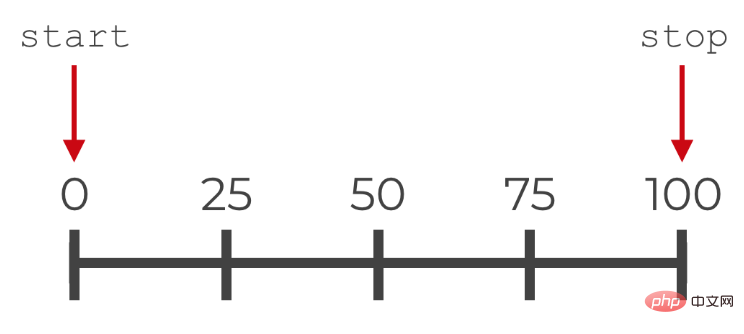
numpy provides the linspace function (sometimes also called np.linspace) which is a tool for creating numerical sequences in python. Similar to the Numpy arange function, generates a uniformly distributed sequence of values with a structure similar to a Numpy array. Although there are some differences between the two, most people prefer to use the linspace function. It is easy to understand, but we need to learn how to use it.
In this article we learn the linspace function and other syntax, and explain the specific parameters through examples. Finally, I would like to mention the difference between np.linspace and np.arange.
Create a numerical sequence by defining uniform intervals. In fact, you need to specify the starting point and ending end of the interval, and specify the total number of separated values (including the starting point and ending point); the final function returns a numerical sequence of uniform distribution of the interval class. Please see the example:
np.linspace(start = 0, stop = 100, num = 5)
The code generates a NumPy array (ndarray object), the result is as follows: array([ 0., 25., 50., 75., 100.])
As shown in the picture:

#Let us explain that the Numpy linspace function generates uniformly distributed values according to the defined interval. We specify the interval using the start and stop parameters, here we set them to 0 and 100, and specify that 5 observations are produced within the range, so the function generates 5 evenly distributed elements. The first one is 0, the last one is 100, and the other three are distributed between 0 and 100.
Let’s take a closer look at the parameters of the linspace function so that you can understand its mechanism more clearly.
The syntax of linspace is very simple and direct. As shown in the figure below, the first is the function name, and the corresponding code is np.linspace (assuming you have imported NumPy as np).

Figure 2
The above figure has three parameters, which are the three most frequently used parameters. There are other optional parameters, whose parameters are discussed below.
In order to understand the parameters, let's look at the diagram again:

start
start The starting point of the parameter value range. If set to 0, the first number of the result is 0. This parameter must be provided.
stop
stop The end point of the parameter value range. Usually it is the last value of the result, but if endpoint = False is modified, the value will not be included in the result (as will be explained in the following examples).
num (Optional) The
num parameter controls how many elements there are in the result. If num=5, the number of output arrays is 5. This parameter is optional, and the default is 50.
endpoint (optional) The
endpoint parameter determines the end value (stop parameter) is included in the result array. If endpoint = True, the end value is included in the result, otherwise it is not. The default is True.
dtype (Optional)
Like other NumPy, the dtype parameter in np.linspace determines the data type of the output array. If not specified, Python infers the data type based on other parameter values. It can be specified explicitly if needed, and the parameter value can be any data type supported by NumPy and Python.
We do not need to use all parameters every time, if the default values can meet our needs. Generally, start, stop, and num are more commonly used than endpoint and dtype.
Positional parameters vs named parameters
There is no need to display the specified parameter name when actually calling, you can directly match it through the parameter position:
np.linspace(0, 100, 5)
The above code and the previous The function of the example is the same: np.linspace(start = 0, stop = 100, num = 5).
The former uses position matching, and the latter uses name matching. Position matching makes the code simpler, and name matching makes the code more readable. In practical applications, we encourage using name matching to call functions.
Let’s learn the meaning of each parameter through examples.
np.linspace(start = 0, stop = 1, num = 11)
The output result is:
array([ 0. , 0.1, 0.2, 0.3, 0.4, 0.5, 0.6, 0.7, 0.8, 0.9, 1. ])
Useful when you need percentage scenarios.
np.linspace(start = 0, stop = 100, num = 11)
The output result is:
array([ 0., 10., 20., 30., 40., 50., 60., 70., 80., 90., 100.])
This example is the same as before, but it is commonly used in practical applications.
As mentioned earlier, the endpoint parameter determines whether the end value is included in the result array. The default is True, which means it is included in the result, otherwise it is not included. Please see the example:
np.linspace(start = 1, stop = 5, num = 4, endpoint = False)
Because endpoint = False, 5 is not included in the result. The result is 1 to 4.
array([ 1., 2., 3., 4.])
Personally, I think this parameter is not direct enough and is generally not used.
默认linspace根据其他参数类型推断数据类型,很多时候,输出结果为float类型。如果需要指定数据类型,可以通过dtype设置。该参数很直接,除了linspace其他函数也一样,如:np.array,np.arange等。示例:
np.linspace(start = 0, stop = 100, num = 5, dtype = int)
这里dtype为int,结果为int类型,而不是float类型。
The above is the detailed content of How to use the linspace function in python numpy. For more information, please follow other related articles on the PHP Chinese website!




